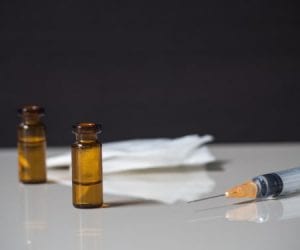Ketamine
 Ketamine is a short-acting anesthetic that can create a dream-like or out-of-body experience if taken in high dosages. As a strong anesthetic, ketamine can affect a person’s sight and hearing, creating a feeling of detachment from his or her body.
Ketamine is a short-acting anesthetic that can create a dream-like or out-of-body experience if taken in high dosages. As a strong anesthetic, ketamine can affect a person’s sight and hearing, creating a feeling of detachment from his or her body.
The U.S. Food & Drug Administration approved the drug in the 1970s for use as an anesthetic for humans and animals. The FDA put ketamine on the controlled substances list in 1999. An estimated 16,000 prescriptions for ketamine were issued in 2012, according to the Drug Enforcement Administration.
Street names for ketamine include:
- Cat Valium
- K
- Kit Kat
- Purple Jet
- Special K
- Special La Coke
- Super Acid
- Vitamin K
Intended Usage
Ketamine is largely used as an anesthetic on animals in veterinary practices, according to the National Institute on Drug Abuse. The medication was also traditionally used as an anesthetic on children. In recent years, doctors have prescribed it off-label to treat those with depression, according to the National Institute of Mental Health. In 2014, the FDA designated the drug as a breakthrough therapy drug for depression in people who require a rapid-acting antidepressant. However, further research must be conducted to determine ketamine’s true value as a longer-term depression treatment.
The FDA classifies ketamine as a Schedule III drug. This means the medication does have known medical uses and has addictive capabilities, but is not considered as addictive as Schedule III drugs, such as morphine.
Side Effects
Side effects associated with taking Kapanol include:
- Constipation when taken regularly
- Dizziness or lightheadedness
- Drowsiness
- Lightheadedness
- Nausea
- Small or constricted pupils
- Trouble urinating
- Vomiting
More serious side effects can include:
- Confusion
- Flushing
- Hallucinations
- Hives
- Hypothermia (extreme cold)
- Severe stomach pain
- Slowed heart rate
Abuse and Addiction
Abusers of ketamine may inject the drug, put it in drinks, snort it or mix it in cigarettes or joints. When taken, abusers may call the experience of using ketamine as “K-Hole” or going to “K-land.” The drug has similar effects and chemical actions to those who abuse PCP. The National Institute on Drug Abuse groups ketamine as a “Club Drug,” like Rohypnol and GHB. Some criminals use ketamine as a date rape drug. The drug is odorless and tasteless.
Signs a person may be under the influence of the substance include:
- Amnesia
- Delirium
- Dream-like states
- Hallucinations
- Impaired attention
- Impaired learning ability
- Impaired memory
With repeated use, abusers can develop a tolerance for the substance and may start to crave the drug. When taken in high dosages, it can have potentially deadly consequences in the form of breathing difficulties. Other serious side effects include poor motor function and very high blood pressure.
Withdrawal Symptoms
Ketamine withdrawal symptoms are not associated with being deadly, but they can be significant enough to deter a person from trying to quit. Examples of ketamine withdrawal symptoms include:
- Depression
- Difficulty hearing
- Double vision
- Poor coordination
- Poor motor skills
- Rapid heartbeat
Ketamine can also cause flashbacks for up to several weeks after it is last used.
Treatment for Ketamine Addiction
Treatments for ketamine addiction can include counseling and supportive therapy, including medications to reduce withdrawal symptoms. Those addicted to the substance often benefit from counseling to help a person understand how his or her drug abuse affects the person and others.
For more information on ketamine abuse or if you think a loved one is suffering from ketamine abuse, please call our drug treatment center at 877-855-3470.